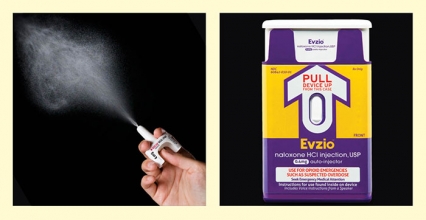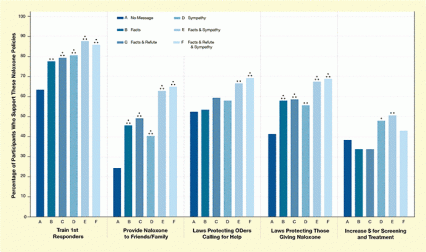This research found that:
- Public health messages can increase public approval for making naloxone legally available to friends and relatives of opioid users to administer if an overdose occurs.
- The most effective messaging combined facts about opioid overdose and the medication with a narrative to elicit sympathy for survivors of overdose victims.
 Figure 1. User-Friendly Delivery Systems for Naloxone In 2014, the Food and Drug Administration approved Narcan® Nasal Spray, a formulation of naloxone packaged in an easy-to-use nasal spray device. Other products, such as the Evzio® auto-injector, also enable nonprofessionals to administer the medication to a person who overdosed on opioids.
Figure 1. User-Friendly Delivery Systems for Naloxone In 2014, the Food and Drug Administration approved Narcan® Nasal Spray, a formulation of naloxone packaged in an easy-to-use nasal spray device. Other products, such as the Evzio® auto-injector, also enable nonprofessionals to administer the medication to a person who overdosed on opioids.The opioid antagonist medication naloxone reverses respiratory depression and arrest resulting from an opioid overdose. Because it must be given promptly, often within minutes, to save a life, some jurisdictions and opioid treatment programs make naloxone readily available to anyone who might encounter a person in overdose status. The medication can be safely and easily administered by auto-injector or nasal spray (see Figure 1), and studies have found that making it available to relatives and friends of opioid users reduces deaths from overdose. However, public opinion has been slow to approve of the practice. Barriers include lack of knowledge about the medication, the stigma associated with opioid use, and concerns that naloxone’s availability could encourage illicit drug use.
Spurred by a sense of urgency over recent high overdose deaths, Dr. Marcus Bachhuber of the University of Pennsylvania and colleagues composed three messages aimed at promoting positive attitudes toward naloxone distribution beyond medical settings. The messages conveyed either (see Excerpts From the Experimental Messages):
- Facts: Statistics about rising opioid overdose rates and facts about naloxone
- Refutation: Rebuttals to common objections to wide naloxone distribution
- Sympathy: A story relating a mother’s sense of loss after her daughter became addicted and died from an overdose of opioids that a doctor had prescribed after the girl was struck by a car
The researchers presented the messages to 1,331 members of the general public who had been recruited by a company that administers online surveys for many sorts of clients. Roughly equal numbers of panelists received either a) the factual information or the sympathetic narrative alone; b) the factual information and sympathetic narrative together; c) the factual information and refutation together; or d) all three messages. After they studied the messages, the panelists were asked how much they supported:
- Training first responders (e.g., paramedics, firefighters, and police officers) to administer naloxone
- Providing naloxone to friends and family members of opioid users
- Passing laws to give legal protection to those who call for emergency assistance during an opioid overdose
- Passing laws to give legal protection to those who administer naloxone to a person who has overdosed on an opioid
- Increasing government spending to screen for and treat opioid dependence
Panelists in all five groups supported at least three of these policies more than did a control group of participants who had not read any of the messages. The panelists who read both the factual message and the sympathetic narrative, with or without the refutation message, indicated the highest levels of support (see Figure 2).
 Figure 2. Messages Increase Support for Naloxone Policies Survey panelists read either factual information or a sympathetic narrative alone; factual information and a sympathetic narrative together; factual information and a refutation of arguments against naloxone distribution together; all three messages; or no message (control group). All the groups that read messages expressed more support for policies to facilitate wider distribution and use of naloxone than the control group. The group that read factual information plus a sympathetic narrative expressed the most support.
Figure 2. Messages Increase Support for Naloxone Policies Survey panelists read either factual information or a sympathetic narrative alone; factual information and a sympathetic narrative together; factual information and a refutation of arguments against naloxone distribution together; all three messages; or no message (control group). All the groups that read messages expressed more support for policies to facilitate wider distribution and use of naloxone than the control group. The group that read factual information plus a sympathetic narrative expressed the most support.Statistical significance
*p<=0.05 compared to the no-message control group using logistic regression.
**p<=0.01 compared to the no-message control group using logistic regression.
***p<=0.001 compared to the no-message control group using logistic regression.
- Text description of Graphic
-
The figure shows a set of bar graphs that show the percentage of participants who support each of five naloxone polices. The five polices are: Train 1st Responders, Provide Naloxone to Friends/Family, Laws Protecting ODers Calling for Help, Laws Protecting Those Giving Naloxone, and Increased funding for Screening/Treatment. Within each of the policies, data for five types of messages are displayed. No message (the control group), factual information, factual information and a refutation of arguments against naloxone distribution together; a sympathetic narrative alone; factual information and a sympathetic narrative together; and the fifth, all three messages – facts, refutation and sympathy
The data show by the bars in the graph are described below:
Statistical significance
*p<=0.05 compared to the no-message control group using logistic regression.
**p<=0.01 compared to the no-message control group using logistic regression.
***p<=0.001 compared to the no-message control group using logistic regression.Policy Message Percentage Statistical Significance Train 1st Responders No Message 63.2% Facts 77.4% p<=0.01 Facts + Refute 79% p<=0.001 Sympathy 80.5% p<=0.001 Facts + Sympathy 87.4% p<=0.001 Facts + Refute + Sympathy 85.7% p<=0.001 Provide Naloxone to Friends/Family No Message 24.4% Facts 45.5% p<=0.001 Facts + Refute 49% p<=0.001 Sympathy 40.1% p<=0.001 Facts + Sympathy 62.6% p<=0.001 Facts + Refute + Sympathy 64.3% p<=0.001 Laws Protecting ODers Calling for Help No Message 52.4% Facts 53.3% No significant difference Facts + Refute 59% No significant difference Sympathy 58% No significant difference Facts + Sympathy 66.5% p<=0.01 Facts + Refute + Sympathy 69.2% p<=0.001 Laws Protecting Those Giving Naloxone No Message 41.6% Facts 58% p<=0.001 Facts + Refute 58.6% p<=0.001 Sympathy 55.6% p<=0.01 Facts + Sympathy 67.7% p<=0.01 Facts + Refute + Sympathy 69.1% p<=0.001 Increase $ for Screening/Treatment No Message 38.5% Facts 33.9% No significant difference Facts + Refute 34.3% No significant difference Sympathy 47.9% p<=0.05 Facts + Sympathy 50.6% p<=0.01 Facts + Refute + Sympathy 43.2% No significant difference
Although the factual message increased support for naloxone distribution, it also was associated with more negative perceptions about naloxone. Panelists who received only the factual message registered more concern, compared to the control group, that some opioid users might misuse naloxone, or treat it as a “safety net” emboldening their misuse of prescription painkillers or use of heroin. However, combining the factual message with either the sympathetic or the refutation message canceled or reversed these negative views.
The researchers surmise that the sympathetic message, because it focused on a parent affected by her child’s overdose rather than on the user of opioids herself, may have compelled some study participants to set aside their perceptions of addiction as a moral failing. Dr. Bachhuber and colleagues conclude that messages that educate the public about the safety and efficacy of naloxone while stirring sympathy for those directly affected by opioid addiction could increase support for liberal naloxone-distribution policies and prevent some fatalities from opioid overdose.
Excerpts From the Tested Messages
Facts Message
“Over the last decade, the number of prescription pain medication overdose deaths has increased by more than 300 percent. Government officials, medical experts, and community leaders have declared prescription pain medication overdoses a national crisis. Naloxone is a medicine that is very effective at saving lives by reversing life-threatening overdoses of prescription pain medication.”
Refutation Message
“Some people don’t believe that the lives of people overdosing on prescription pain medication are worth saving. They say that using naloxone to save a person overdosing is pointless because the person will just continue using… But in fact, many people who overdose and are saved because of naloxone will see it as a wake-up call and enter treatment for their addiction.”
Sympathy Message
“Mother’s Day has become a difficult time for Mary since she lost her daughter, Erika, to an overdose of prescription pain medication 2 years ago. It all started after Erika was hit by a car…. Mary suspected Erika had developed an addiction to prescription pain medication and tried to convince her to get help…. She finally found a clinic…but the first available appointment was several weeks away…. A few days later, she came home from work and found Erika on the bathroom floor, barely breathing.”
This study was supported by NIH grant DA026414.
Source:
Bachhuber, M.A.; McGinty, E.E.; Kennedy-Hendricks, A. et al. Messaging to increase public support for naloxone distribution policies in the United States: Results from a randomized survey experiment. PLoS ONE 10(7): e0130050. Full Text
